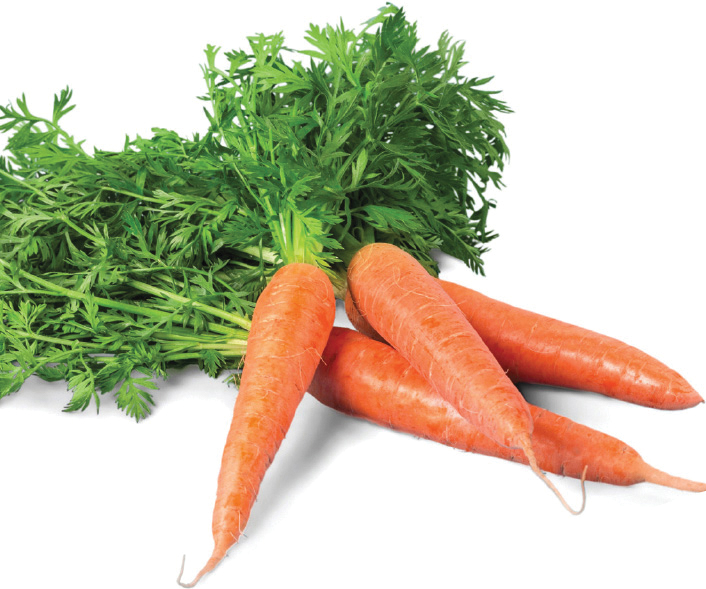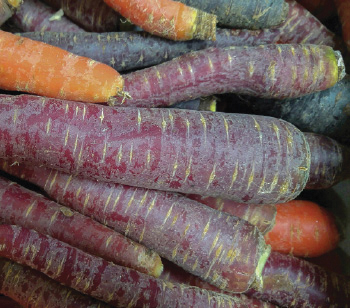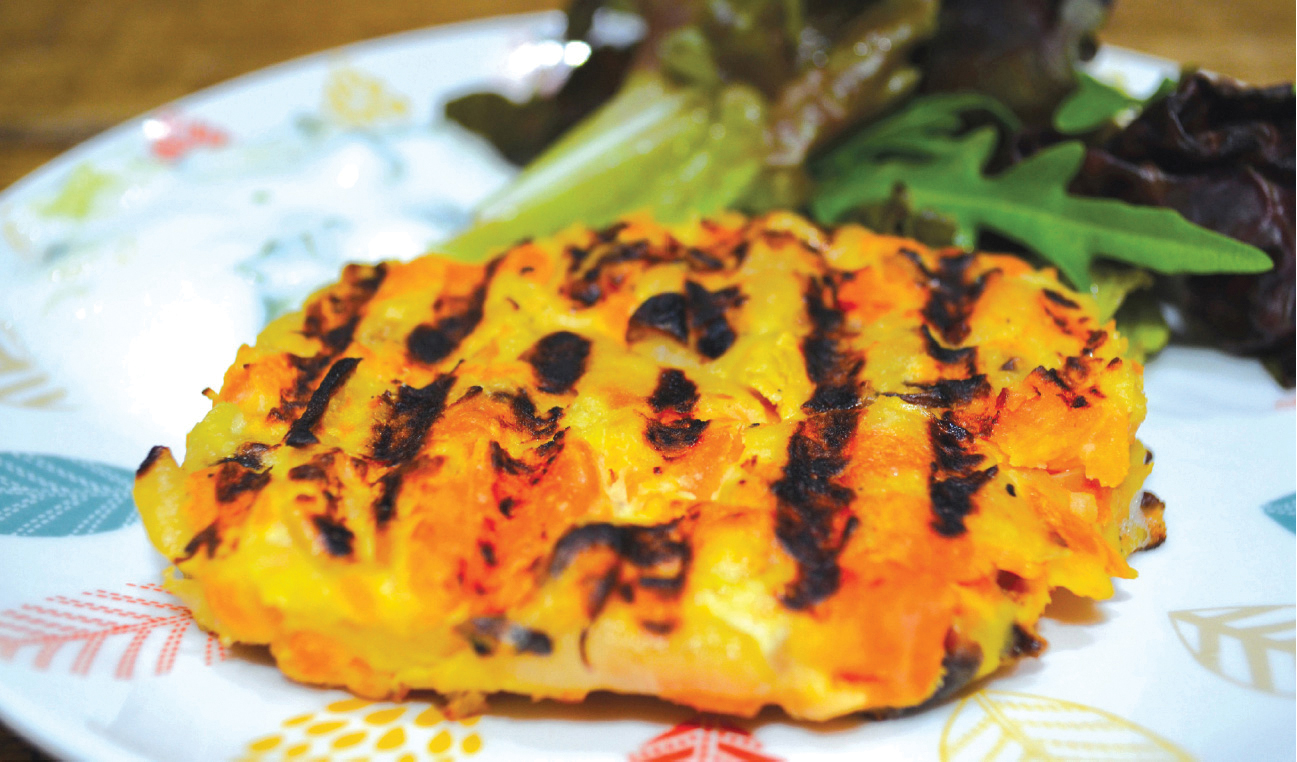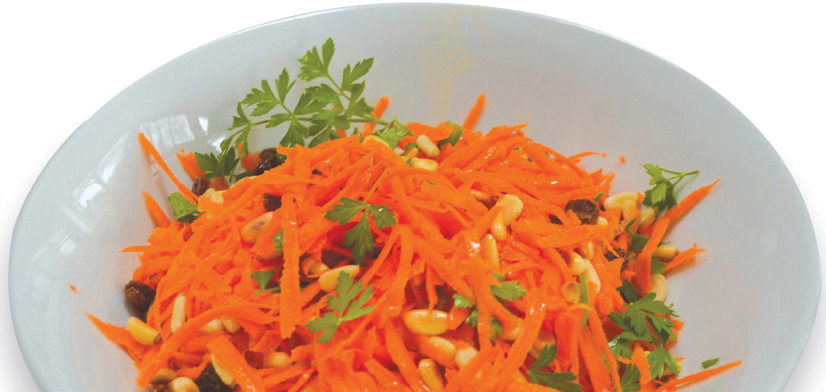 Love them
Love them Love them
Love them
Vegetables don’t get much more ubiquitous than carrots, which may explain why they rarely receive much attention. But while they are often regarded as more of a staple than a superfood, the familiar orange roots do have their own super properties. If your grandmother said they would help you see in the dark, she had a point. Carrots are packed with beta-carotene, an antioxidant, which is converted into vitamin A by the body and is essential for eye health. Beta-carotene is also responsible for the vibrant colour associated with carrots and other orange and yellow fruits and vegetables.

Just one carrot will provide more than twice the amount of vitamin A needed for one day ...
Just one carrot will provide more than twice the amount of Vitamin A needed for one day. Besides helping with vision, vitamin A is also needed for immune function and healthy skin. Studies have also shown that beta-carotene may offer some natural UV protection, helping to defend the skin from sun damage – although consuming large quantities of carrots isn’t recommended as an alternative to using sunscreen. And while consuming too much vitamin A can be toxic, the body only converts beta-carotene into as much vitamin A as it needs, making it hard to overdose on carrots – although excessive quantities could cause your skin to turn yellow or orange. Fortunately, this is reversible!
In addition to beta-carotene, carrots also provide vitamins C and K and are a good source of fibre.
 Grow them
Grow them
There is simply no comparison between a shop-bought carrot and one you have grown yourself. Despite their ubiquity, carrots are one of the vegetables that benefit most from being home-grown. Commercially churned out varieties tend to be watery, bizarrely odourless and almost translucent (not to mention laden with pesticides) whereas home-produced ones are densely crunchy and flavoursome. It’s like the difference between butter and margarine, and only one of those deserves any fridge space.

Carrots are one of the vegetables that benefit most from being home-grown ...
What’s more, while mass produced carrots are unswervingly orange, there’s a wide selection of colours to choose from if you grow your own, including: red, yellow, white and even purple. Go crazy and grow a rainbow!
Carrots are very easy to grow. The main issue is protecting them from carrot fly (see below.)
There are two broad categories of carrots; sweet, summer varieties which can be sown in early spring and picked from May onwards, and maincrop carrots which are sown and harvested later, and will last through the winter if you’re lucky.
In March, prepare the soil by digging and raking to break up any lumps. Remove as many stones as you can.
Don’t add manure just before sowing, as this will encourage the carrots to fork. Although if they do it’s not the end of the world, they just won’t win any prizes for looks.
Once the soil is nice and crumbly, create a drill, or narrow channel, in which to sow your seeds. A bamboo cane, or long pole, pressed into the ground does the job for you. Or you can drag a stick, or the end of the rake, along the soil in a straight line.
Water the drills first, then sow the seeds as thinly as possible, ideally leaving about 5cm between each seed. Or you can mix the seed with fine compost or sand before sowing, to help space them out. Leave about 30cms between additional rows. Cover the seeds with fine soil and water gently using a watering can with a rose nozzle so as not to wash the tiny seeds away.
Water occasionally until the seedlings appear, and then only during very dry spells. The weeds will inevitably grow first, but the carrot tops will eventually catch up. Pull the weeds out by hand once the carrots are sturdy enough not to get ripped out in the process. Carrots don’t like being disturbed and might respond to any meddling by going a bit floppy, but they will soon recover.

Varieties to try:
‘Nantes ‘ – fast-maturing for early pickings.
‘Autumn King’ – a popular, heavy cropping maincrop carrot that stores well.
‘Purple Haze’ – purple skin with orange flesh.
‘Parmex’ – produces short round-rooted carrots, ideal for growing in containers
‘Flyaway’ – bred to be resistant to carrot fly.
Enemy number one when it comes to growing carrots is the carrot fly – a tiny insect that can sniff out a carrot from a mile away. It lays its eggs all over the place, and these hatch into maggots that tunnel through the carrots leaving them brown and inedible. Fortunately, there are ways to prevent it from happening in the first place.
Covering your carrots with insect-proof mesh or netting is by far the best method of keeping your carrots in top condition - or any kind of condition at all. A good way to do this is to make a tunnel using pieces of water pipe bent into semi-circles, or even cheap hula-hoops cut in half, then drape the netting over the frame. Although it can seem like an expense at the time, the netting will last for years and is one of the most worthwhile investments you can make when growing your own food.
The following methods can also be used to deter carrot fly, but these are best used in addition to netting, as an added line of defence:
Companion planting
Plant strong smelling crops like garlic and onions near your carrots as a natural deterrent.
Timing
Pick or thin your carrots on a dull day to minimize the scent which attracts the carrot fly.
Crop rotation
Don’t plant carrots in the same spot on consecutive years, as the pupae can stay in the ground over winter and re-emerge in the spring. Though of course, crop rotation won’t prevent a new invasion of carrot fly, so this method on its own is unlikely to succeed.
Read the label
If risking a net-free approach, opt for seeds with carrot-fly resistance.
Use a fork or hand fork to dig up carrots. If the soil is very dry, water it first. For winter storage, carrots can be dug up and arranged in layers in boxes (the carrots shouldn’t touch each other) and then covered with sand or compost. However, I’ve always found that carrots will survive in the ground until needed, right through until spring, which saves the time and hassle of having to store them. In cold, frost prone regions, it’s advisable to cover the ground with a layer of straw.

CARROTS RARELY RECEIVE much love in the kitchen. When short of time or ideas, I often resort to handing them out raw with a pot of hummus, which beats serving them as a soggy, disintegrating heap on the edge of the plate. The nutritional content of carrots is actually enhanced by gentle cooking, but that doesn’t mean you need to boil them to oblivion. Forget school dinners, these two recipes provide carrots with a much-needed makeover.

Roasted carrot and butterbean burgers with tzatziki
Cheaper than chips and with very simple ingredients. Roasting the carrots first really brings out the flavour and while they are in the oven you can get on with something else.
Serves 4
• 800g carrots
• 400g tin of butterbeans, drained
• 2 small onions
• 2 eggs, beaten
• A splash of rapeseed or olive oil
• Salt and pepper to season
For the tzatziki
• 150g natural yoghurt
• 4 tablespoons fresh mint, finely chopped
• 1 tablespoon lemon juice
• Half a cucumber, finely diced
• 1 clove of garlic, crushed (optional)
• Preheat the oven to 190°C/170°C fan/gas 5.
• Dice the carrot and onion into smallish chunks and place in a roasting dish. Drizzle over the oil and mix so that everything is coated, then season with salt and pepper.
• Place in the oven for around 30 minutes, until the carrots are softened, but not falling apart.
• While the carrots are cooking make the tzatziki by mixing all the ingredients together.
• Remove the carrots from the oven and allow to cool slightly. Add the butterbeans and mash everything together leaving a fairly rough texture. Mix in the beaten egg, then shape into burgers. The mixture can also be made in advance and left in the fridge which firms it up a bit.
• Cook the burgers on a griddle, or in a frying pan, for a few minutes on each side. Serve with the tzatziki, salad and a bun.

Tastes-like-summer carrot salad
A fresh, vibrant salad, without the cloyingness of coleslaw. Don’t worry too much about sticking to exact quantities here, just do what works for you.
Serves 4-6 as a side dish
• 6-8 good sized carrots, coarsely grated or cut into ribbons
• 125g sultanas
• 50g pine nuts
• 2 tablespoons lemon juice
• 4 tablespoons olive oil
• A handful of parsley, or coriander, chopped
• Salt and pepper to season
• Soak the sultanas in hot water for 5 minutes to plump them up, then drain.
• Meanwhile, dry fry the pine nuts over a low heat, stirring all the time until they change colour. Transfer to a plate to cool.
• Combine the carrots, sultanas, lemon juice, olive oil, parsley or coriander, and pine nuts and mix well.
• Season to taste and serve.